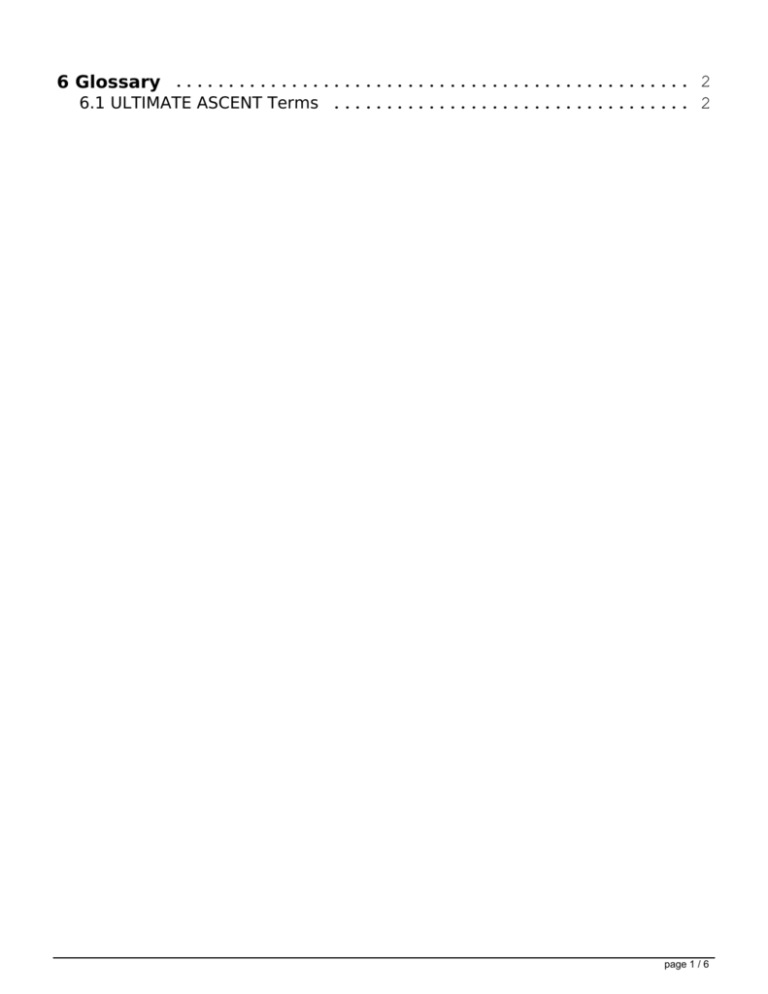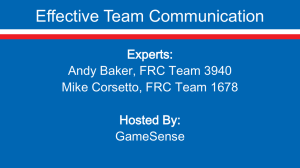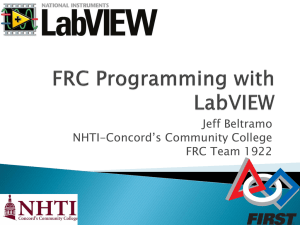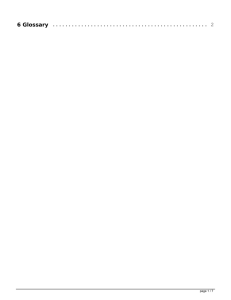
6 Glossary ................................................. 2
6.1 ULTIMATE ASCENT Terms .................................. 2
page 1 / 6
6 Glossary
FIRST®, the FIRST® logo, FIRST® Robotics Competition, FRC ®, Coopertition®, and Gracious
Professionalism® are registered trademarks, and Sport for the Mind™ and ULTIMATE ASCENTSM are common
law trademarks, of the United States Foundation for Inspiration and Recognition of Science and Technology
(FIRST®). ©2013 FIRST. All rights reserved.
6.1 ULTIMATE ASCENT Terms
ALLIANCE: a set of three Teams (four if counting a BACKUP ROBOT) who play ULTIMATE ASCENT together.
ALLIANCE CAPTAIN: a designated student representative from the ALLIANCE Lead.
ALLIANCE STATION: the area bounded by the ALLIANCE WALL, FEEDER STATIONS, LOW GOAL, white tape and
carpet perimeter depicted in Figure 2.3.
ALLIANCE WALL: a 6 ½ ft high, 18 ft wide, wall that defines the ends of the FIELD.
ARENA: all elements of the game infrastructure required to play ULTIMATE ASCENT: the FIELD, the ALLIANCE
STATIONS, the DISCS, and all supporting communications, ARENA control, and scorekeeping equipment.
AUTO: the first 15 seconds of the MATCH in which ROBOTS operate without direct DRIVER control.
AUTO LINE: a line, marked in Red or Blue gaffers tape, located 108 in. from and parallel to the CENTER LINE.
AUTO ZONE: an area on either end of the FIELD bounded by the ALLIANCE WALL, FEEDER STATIONS, LOW
GOAL, GUARDRAILS, and the nearest AUTO LINE.
BACKUP TEAM: a Team used to replace an inoperable ROBOT on an ALLIANCE during Elimination MATCHES per
Section 5.5.6.
BUMPER: a protective assembly designed to attach to the exterior of the ROBOT and constructed as specified in
Section 4.1.6, BUMPER Rules.
BUMPER ZONE: the volume contained between two virtual horizontal planes, 2 in. above the floor and 10 in. above
the floor.
CENTER LINE: the line, marked in White gaffers tape, which bisects the length of the FIELD.
CLIMBING/CLIMB: the action of ascending the PYRAMID, defined in Section 3.1.5.2.
COACH: a student or adult Mentor identified as the person wearing the designated "COACH" pin or button during a
MATCH.
page 2 / 6
COMPONENT: any part in its most basic configuration, which cannot be disassembled without damaging or destroying
the part or altering its fundamental function.
COTS: a “Commercial, Off-The-Shelf” COMPONENT or MECHANISM, in its unaltered, unmodified state. A COTS
item must be a standard (i.e. not custom order) part commonly available from the VENDOR, available from a
non-Team source, and available to all Teams for purchase.
Example 1: A Team orders two ROBOT grippers from RoboHands Corp. and receives
both items. They put one in their storeroom and plan to use it later. Into the other, they
drill “lightening holes” to reduce weight. The first gripper is still classified as a COTS
item, but the second gripper is now a “custom part” as it has been modified.
Example 2: A Team obtains openly available blueprints of a drive component commonly
available from Wheels-R-Us Inc. and has local machine shop “We-Make-It, Inc.”
manufacture a copy of the part for them. The produced part is NOT a COTS item,
because it is not commonly carried as part of the standard stock of We-Make-It, Inc.
Example 3: A Team obtains openly available design drawings from a professional
publication during the pre-season, and uses them to fabricate a gearbox for their ROBOT
during the build period following Kickoff. The design drawings would be considered a
COTS item, and may be used as “raw material” to fabricate the gearbox. The finished
gearbox itself would be a FABRICATED ITEM, and not a COTS item.
Generally available software modules obtained from open sources (e.g. professional
publications, commonly used FRC community-accessible web resources, industry source
code repositories, etc.) that are not specifically affiliated with individual FRC Teams are
considered COTS items.
DISABLED: a state in which a ROBOT has been commanded by the Driver Station to deactivate all outputs.
DISC: the game piece used in ULTIMATE ASCENT.
DISQUALIFIED: the status of a TEAM, as determined by the Head Referee, in which they receive zero (0) Qualification
Points in a Qualification MATCH or receive zero (0) points in an Elimination MATCH.
DRIVER: a pre-college student TEAM member responsible for operating and controlling the ROBOT.
FABRICATED ITEM: any COMPONENT or MECHANISM that has been altered, built, cast, constructed, concocted,
created, cut, heat treated, machined, manufactured, modified, painted, produced, surface coated, or conjured partially
or completely into the final form in which it will be used on the ROBOT.
FEEDER: a pre-college TEAM member that feeds DISCS to ROBOTS.
FEEDER SLOT: an opening in a FEEDER STATION through which FEEDERS enter DISCS on to the FIELD.
FEEDER STATION: the FIELD border element containing the FEEDER SLOTS.
FIELD: the area bounded by and including the GUARDRAILS, ALLIANCE WALLS, LOW GOALS, and FEEDER
STATIONS.
page 3 / 6
FIELD TIMEOUT: a TIMEOUT called by the Head Referee.
FOUL: a penalty assessed by a Referee which credits the opponent with three (3) points.
FRAME PERIMETER: the polygon defined by the outer-most set of exterior vertices on the ROBOT (without the
BUMPERS attached) that are within the BUMPER ZONE. To determine the FRAME PERIMETER, wrap a piece of
string around the ROBOT at the level of the BUMPER ZONE - the string describes this polygon.
Note: to permit a simplified definition of the FRAME PERIMETER and encourage a tight,
robust connection between the BUMPERS and the FRAME PERIMETER, minor
protrusions such as bolt heads, fastener ends, rivets, etc are excluded from the
determination of the FRAME PERIMETER.
GOAL: a FIELD element in which DISCS are SCORED to earn points for an ALLIANCE.
GUARDRAIL: a system that borders the length of the FIELD and consists of horizontal pipes, vertical struts, and
polycarbonate shields.
HIGH GOAL: the GOAL centered over the ALLIANCE WALL.
Kit of Parts (KOP): the collection of items listed on any Kit of Parts Checklist, available in FIRST® Choice, or obtained
via a Product Donation Voucher (PDV)
LOADING ZONE: a trapezoidal area bounded by two (2) FEEDER STATIONS, an ALLIANCE WALL, a GUARDRAIL,
and Red or Blue tape.
LOW GOAL: the GOAL located between a FEEDER STATION and ALLIANCE WALL.
MATCH: a two (2) minute and fifteen (15) second period of time in which ALLIANCES compete in ULTIMATE
ASCENT.
MECHANISM: a COTS or custom assembly of COMPONENTS that provide specific functionality on the ROBOT. A
MECHANISM can be disassembled (and then reassembled) into individual COMPONENTS without damage to the
parts.
MIDDLE GOAL: a GOAL located above the ALLIANCE WALL and adjacent to the HIGH GOAL.
OPERATOR CONSOLE: the set of COMPONENTS and MECHANISMS used by the DRIVERS to relay commands to
the ROBOT.
PLAYER STATION: a position behind the ALLIANCE WALL from where a TEAM operates their ROBOT.
PLAYING CONFIGURATION: The physical configuration and orientation of the ROBOT while playing the game (i.e.
after the MATCH has started, and the ROBOT has deployed mechanisms, moved away from the starting location,
and/or interacted with the field, GAME PIECES, or other ROBOTS). This configuration is dynamic, and may change
multiple times during the course of a single MATCH.
PYRAMID: the Red or Blue steel structure on which ROBOTS CLIMB for points.
PYRAMID GOAL: a GOAL positioned on top of a PYRAMID.
page 4 / 6
RED CARD: a penalty assessed which DISQUALIFIES a TEAM, see Section 5.5.4.
ROBOT: an electromechanical assembly built by an FRC Team to perform specific tasks when competing
in ULTIMATE ASCENT. It includes all of the basic systems required to be an active participant in the game: power,
communications, control, mobility, and actuation. The implementation must obviously follow a design approach
intended to play ULTIMATE ASCENT (e.g. a box of unassembled parts placed on the FIELD or a ROBOT designed to
play a different game would not satisfy this definition).
SCORED: A DISC is considered SCORED in an ALLIANCE’S GOAL if any part of the DISC has crossed through the
opening of the GOAL, is in the GOAL at the end of the MATCH, and the DISC is not in contact with any ROBOT from
that ALLIANCE. Additionally, for a DISC to be considered SCORED in an ALLIANCE’S PYRAMID GOAL, it must
correspond to the PYRAMID color.
STARTING CONFIGURATION: The physical configuration and orientation of the ROBOT when the MATCH is started.
This is the state of the ROBOT immediately before being Enabled by the Field Management System, before the
ROBOT takes any actions, deploys any mechanisms, or moves away from the starting location. This configuration is
static, and does not change during a single MATCH (although it may change from MATCH to MATCH). In the
STARTING CONFIGURATION, no part of the ROBOT may extend outside the vertical projection of the FRAME
PERIMETER, with the exception of minor protrusions such as bolt heads, fastener ends, rivets, etc.
If a ROBOT is designed as intended and pushed up against a vertical wall (in STARTING
CONFIGURATION and with BUMPERS removed), only the FRAME PERIMETER (or
minor protrusions) will be in contact with the wall.
STARTING LINE: the line, marked in White tape, located 4 ft. behind the ALLIANCE WALL behind which TEAM
members must stay during AUTO.
SURROGATE: a Team randomly assigned by the Field Management System to play an extra Qualification MATCH,
detailed in Section 5.3.2.
TEAM: 1 COACH, 2 DRIVERS, and 1 FEEDER from the same FRC Team.
TECHNICAL FOUL: a penalty assessed by a Referee which credits the opponent with twenty (20) points.
TELEOP: the remaining two (2)-minutes of a MATCH in which ROBOTS may be directly controlled by DRIVERS.
TIMEOUT: a period of up to six (6) minutes, which an ALLIANCE can use to pause Elimination MATCH progression.
VENDOR: a legitimate business source for COTS items that satisfies all of the following criteria:
A. has a Federal Tax Identification number. In cases where the VENDOR is outside of the United States, they
must possess an equivalent form of registration or license with the government of their home nation that
establishes and validates their status as a legitimate business licensed to operate within that country.
B. is not a “wholly owned subsidiary” of an FRC Team or collection of FRC Teams. While there may be some
individuals affiliated with both an FRC Team and the VENDOR, the business and activities of the Team and
VENDOR must be completely separable.
C. must be able to ship any general (i.e., non-FIRST unique) product within five business days of receiving a valid
purchase request. It is recognized that certain unusual circumstances (such as 1,000 FIRST Teams all ordering
the same part at once from the same VENDOR) may cause atypical delays in shipping due to backorders for
even the largest VENDORs. Such delays due to higher-than-normal order rates are excused.
page 5 / 6
D. should maintain sufficient stock or production capability to fill Teams’ orders within a reasonable period during
the build season (less than 1 week). (Note that this criterion may not apply to custom-built items from a source
that is both a VENDOR and a fabricator. For example, a VENDOR may sell flexible belting that the Team
wishes to procure to use as treads on their drive system. The VENDOR cuts the belting to a custom length from
standard shelf stock that is typically available, welds it into a loop to make a tread, and ships it to a Team. The
fabrication of the tread takes the VENDOR two weeks. This would be considered a Fabricated Item, and the
two weeks ship time is acceptable.) Alternately, the Team may decide to fabricate the treads themselves. To
satisfy this criterion, the VENDOR would just have to ship a length of belting from shelf stock (i.e. a COTS item)
to the Team within five business days and leave the welding of the cuts to the Team.)
E. makes their products available to all FRC Teams. VENDOR must not limit supply or make a product available
to just a limited number of FRC Teams.
The intent of this definition it to be as inclusive as possible to permit access to all
legitimate sources, while preventing ad hoc organizations from providing special-purpose
products to a limited subset of Teams in an attempt to circumvent the cost accounting
rules. FIRST desires to permit Teams to have the broadest choice of legitimate sources
possible, and to obtain COTS items from the sources that provide them with the best
prices and level of service available. Teams also need to protect against long delays in
availability of parts that will impact their ability to complete their Robot. The FRC build
season is brief, so the Vendor must be able to get their product, particularly FIRST
unique items, to a Team in a timely manner. Ideally, chosen Vendors should have
national distributors (e.g. Home Depot, Lowes, MSC, Radio Shack, McMaster-Carr,
etc.). Remember, FRC events are not usually near home – when parts fail, local access
to replacement materials is often critical.
VISION TARGET: a retro-reflective target, made of 3M 8830 Silver Marking Film, that may be used by ROBOTS to
sense FIELD elements.
YELLOW CARD: a warning for egregious ROBOT or FRC Team member behavior.
page 6 / 6
Powered by TCPDF (www.tcpdf.org)








